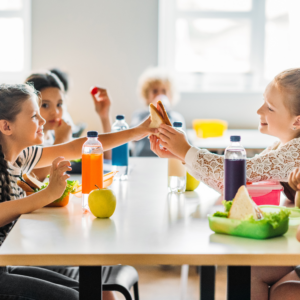Sarah Besand, a Teacher and Possip Reporter, shares cafeteria procedures for teachers and other school leaders.
Let’s talk cafeteria. Administrators, we know it’s probably not the top thing on your list. We know the schedule, the vendors, and the daily mess can be overwhelming. But we also know that setting high-quality and aligned procedures at the beginning of the year will save you and your staff members many lunchtime headaches in the future.
We’ve compiled some specific and digestible (no pun intended!) tools that will make you and your staff’s lives much easier this year during student lunchtime. It is entirely possible for both students and staff to get what they need during this time.
To give you a little comfort, cafeteria concerns are something on the minds of families and staff across the country and the globe. According to last year’s Possip staff feedback trends at the beginning of the school year, student behavior in the cafeteria was #4 on the list, and staff generally expressed a need for more support in terms of cafeteria procedures.
There are several articles and blogs containing “hacks” to implement for schools that need to course-correct their energetic cafeteria settings during the year. Check one out here. We are truly all navigating this challenge together.
At Possip, we aim to provide you with tools to adopt preemptively as you begin this upcoming school year. These tools will help set the tone for what is expected as the year kicks off and keep the standard consistent when students push expectations throughout the year. As educators and administrators, we know our beloved students may try to see what they can get away with as the year progresses!
Here are our top tips on cafeteria procedures that are destined to help your school succeed at lunchtime
1. Decide on specific procedures…and stick to them (unless you have a system that is clearly an improvement)!

- How would your ideal cafeteria scenario feel? For students? For staff members?
- What would the volume level sound like? Where is the limit?
- If someone walked by the cafeteria and peeked inside, what would it look like?
- Do these expectations change for students depending on their age? Talk through and decide on the details.
Then, communicate this vision to the students as a united team. And then communicate it again. And again if/when they test a boundary. Revisit and practice the expectations you’ve outlined until the desired procedure is met. This is critical to success in the cafeteria for everyone involved.
2. Consider open seating
We know this idea may send you reeling. When you think of open seating, you might visualize chaos and a general lack of control which, with food involved, could lead to some pretty sticky situations. However, we suggest this idea to actually minimize volume and conflict. By implementing this strategy, students can chat with their peers without increased volume across tables. Consider open seating within classrooms or grade levels. Giving students choices can be used as a positive incentive. Use it to your advantage!
3. Utilize group and individual incentives
We all know the importance of incentives to reinforce positive student behavior. However, in a loud and chaotic lunchroom, it can be difficult for anyone to remember! This Possip article, “Incentives in the Classroom”, reminds us of different ways to use incentives at school, and we recommend trying these same strategies in the cafeteria. The ideas inside this resource include individual as well as group incentives, and both of these can easily be implemented during student lunchtime. Try out using an individual point system or “table points” this school year to encourage student positive behavior throughout the cafeteria. Both of these strategies will likely help students work together to accomplish a common goal.
We hope these suggestions inspire you and your staff to create cafeteria procedures that align with the vision and tenor of your school and set up your students for success this year! Keep imagining what your ideal lunchtime routine will look like, and make it happen with continual resetting if and when it’s necessary. Working toward this vision together will ensure a smooth daily lunch break and will keep the cafeteria headaches at bay!


